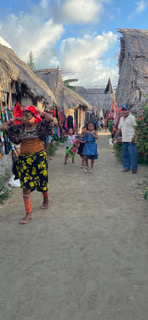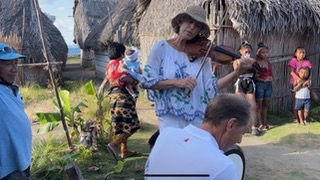09:28.363N 078:57.858W A Cultural Exchange

Saturday, 5th February, was a feast for all the
senses. At first light James, Stuart, Louis and I went ashore in the tender to
explore the island at Lemmon Cays. We approached the island restaurant gingerly,
still on constant look out for bommies and other possible dangers, docked the dingy
and stepped onto the wooden jetty. The six stilted cabanas jutting out from the
beach seemed luxurious by San Blas standards, with running water, delivered by
above ground pipes, with periodic leaks, keeping the ground moist underfoot. Solar
panels on each roof provided the occupants with adequate electricity. We were
charmed by the electric light poles dotted here and there, with cutoff 5-liter
plastic bottle lamp shades! Walking through the center of the island, we noted
how well kept the island was and how well built the various structures were. We
did a short yoga session on the beach at the far side and then returned to the
restaurant for breakfast. We were hoping for a menu with tropical coconut pancakes
and banana fritters. The friendly waiter asked how many we were and brought a
large bright pink Thermos, a jar of instant coffee and sachets of sugar and
powered milk, followed by 4 plates each with 2 slices of very white toast, a
fried egg, a slice of Spam-like ham and a plastic wrapped piece of Easi-Single
cheese. The constant high winds (natural air conditioning) had its own plans
for the powdered milk, and those did not include the coffee cup! We giggled, drank,
and ate, delighted to be on stable ground, in a restaurant, eating at our leisure. 12:30 that afternoon was the departure time for the Carti islands,
where Aaron, the government agent who seems to have a hand in all things San
Blas, had organized a traditional dance show for rally participants. There was
much discussion on what to wear to be polite - long sleeves and long trousers was
the chosen costume. At 16:30 a boat arrived to collect us, and the crew of Intrepid,
fellow rally participants. We were regaled with tales of the Guna/Dule peoples
by our tour guide “Mr. G”, Aaron’s cousin. The small group of Carti islands are
among the busiest and certainly the most densely populated in the San Bals archipelago.
The island dwellings spill out onto the beach and on stilts into the sea on all
sides. We arrived ashore on Carti Yandup to swarms of cheerful children and
Aaron, his lovely wife and daughter. Mr G had said that we could take photos
and ask as many questions as we wanted. We had been pre warned to bring lots of
candy for the children. John kindly raided the best English sweet shop and supplied
us with pounds of licorice allsorts and jelly babies. The kids were thrilled. Carti Yandup was like stepping back in time to a medieval
village – coconut frond rooves, bamboo walls and dirt floors. All that was
missing were the sewage ditches on either side of the narrow streets. We had
the rare opportunity to step inside the ceremonial town hall, where the 3
chiefs of the village hold court most evenings. The chiefs were not in attendance,
but their 3 hammocks lay in waiting. All along the way to the center of the settlement
we were followed by candy-hungry children and greeted by mostly women of all
ages, touting their handicrafts. Mr. G explained that the children were on
school holiday until next week. It appears we had been given incorrect
information regarding schooling previously. On the adjacent island, Carti Tupile,
there is a school and the children of Carti Yandup are ferried over there daily
for classes. We hope to pay a visit to the school next week. The dance show was an exquisite view of many generations of
Guna life and legend. The dancers were all teenagers, 6 girls, 5 boys and the
dance master. The males wore bright yellow shirts and various dark trousers,
the females, traditional mola embroidered blouses and ethic patterned fitted skirts.
The boys played pan pipe handmade flutes and the girls, shook maracas. The
girls’ dance moves were very poised with small repetitive steps and slight body
movements. The boys were more athletic. They were often bowed forward, punctuated
by air borne leaps and energetic twists and turns, all as they played the wispy,
husky flute. Many of the villagers were in the audience too, leaning against
village huts, sitting on the dusty ground, or on rickety chairs while we sat on
special benches set up for the occasion. The village children laughed and
played, wrestled and jostled, like children anywhere in the world. The older
ladies wore traditional garb, but the children wore regular western clothing.
It was a jolly community affair. Aaron had asked us on our first day in the San Blas if we
would play some Irish music at the dance party, so Louis and I had brought our
instruments along. We played 2 tunes and were asked for 2 encores. It was
lovely to see the amazed faces on the children, who probably had never seen a
violin before. One of our ambitions on this trip is have as many cultural
exchanges as we can, this was our first! After the Irish music seisiún, we were all invited by the dance master to learn the Guna dance. We had a new appreciation of the difficulty inherent in the apparently simple steps. Visit Linkedin; #chartingirenevoyage, to see a fascinating discussion between Louis and Mr. G.about the plastic waste problem in the San Blas.
|


